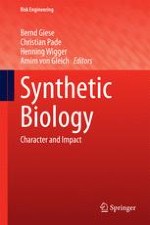2015 | OriginalPaper | Buchkapitel
Characterizing Synthetic Biology Through Its Novel and Enhanced Functionalities
verfasst von : Christian Pade, Bernd Giese, Stefan Koenigstein, Henning Wigger, Arnim von Gleich
Erschienen in: Synthetic Biology
Aktivieren Sie unsere intelligente Suche, um passende Fachinhalte oder Patente zu finden.
Wählen Sie Textabschnitte aus um mit Künstlicher Intelligenz passenden Patente zu finden. powered by
Markieren Sie Textabschnitte, um KI-gestützt weitere passende Inhalte zu finden. powered by
